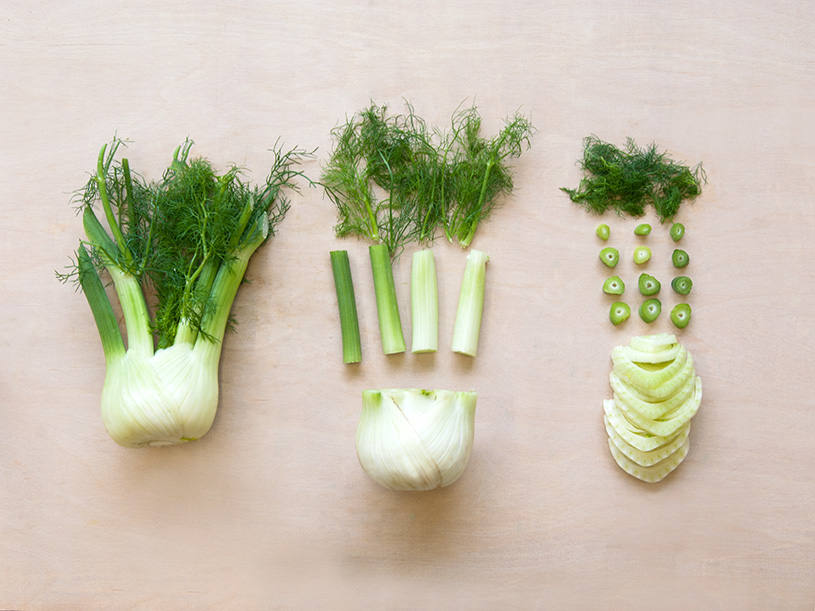Why Fennel is Fabulous
It’s crunchy. It’s tasty…and it’s one of the few fresh veggies in season all winter long. There are so many reasons to love fennel. But with its unusual appearance and subtle licorice-y flavour, it’s no wonder many home cooks find fennel intimidating. Luckily, we’re here to make some introductions. And hopefully before long, you’ll be loving fennel just as much as we do.
What is fennel?
Fennel originally comes from the Mediterranean region – which explains why it’s such a popular ingredient in French, Italian and Spanish cuisine. It comes from the Umbellifereae family, meaning it’s related to parsley, carrots and dill. And the taste? Well…it’s not quite like anything else. Eaten raw, fennel is crunchy, sweet and refreshing – like a cross between celery and anise. Cooked, it can develop sweet, caramelized flavours not unlike a leek. Best of all, this marvelous plant is edible “root to tip” – you can eat the bulb, stems, leaves and seeds!
Is fennel good for me?
Heck yes, it is! Just like celery, fennel is filling and low in calories (about 27 kCals per cup) – and with its high water content, it’s great for hydration. It’s packed with fibre, potassium, vitamin C and folate – a B vitamin that makes and repairs DNA. Best of all, fennel has a uniquely healthy combination of phytonutrients, including the powerful antioxidants quercetin and rutin. Never heard of ‘em? That’s okay. All you need to know is…a little fennel in your diet is most definitely a good thing. And chances are, you’re already familiar with the benefits of fennel seeds. Whether brewed into a tea or chewed after a meal, they’ve been used for thousands of years to aid digestion, freshen the breath and relieve stomach aches.
How do I choose the perfect bulb?
Whether you’re shopping for baby or full-grown fennel, look for firm, clean bulbs with closely spaced stalks, feathery green fronds and no brown spots. If your bulb has flowers on the stalks, it’s a no-go – flowering fennel is past its prime. Once you get it home, eat your fennel right away. More than a few days in the fridge can drain it of flavour and freshness.

How the heck do I cut it?
It’s easier than you might think! If you’re working with baby fennel, there’s very little you need to do: you can eat the whole veggie – stalks, bulb and all. Just slice it up and cook however you desire. If you’re prepping full-grown fennel, the stalks are often too tough to eat as-is. Trim the stalks off where they meet the bulb, and save them for soups, stews or stocks – or better yet, pickle them!
To slice the bulb, cut it in half and trim off the base. Then, thinly slice it and get cooking. Some people like to quarter the bulb length-wise and trim off the core – but this is up to you. Most importantly, don’t toss those gorgeous green fronds. Save them for a garnish, or use them like you would any herb.
Ready to give fennel a try? Here are some easy ideas to get you started…
Raw
-Thinly slice some fennel bulbs and toss them with lemon juice, olive oil and shaved parmesan cheese.
-Add shaved fennel to a side salad – we love it with crisp greens, citrus segments and goat cheese.
-Try quick pickling fennel, and using it as a sandwich topping or potato salad add-in.
Cooked
-Toss wedges of fennel with cubes of your favourite root veggies. Drizzle with olive oil, salt + pepper, and roast for 45 minutes.
-Wrap a bulb in foil with garlic, lemon zest and olive oil, then bake until tender.
-Try swapping out celery for fennel in your favourite soup, stuffing or sauté.
-Add fennel to your favourite fish broth or seafood chowder – it’s delicious in bouillabaisse!
-Cut it in half, drizzle with olive oil and pop it on the grill until lightly browned all over.
What’s your favourite use for fabulous fennel? Let us know at blog@madradish.com.


